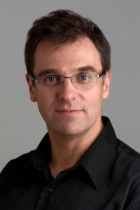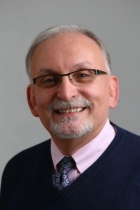Faculty Honors and Awards
Jochen Autschbach Receives 2019 Schoellkopf Medal
Adapted from a UBNow article by UBNow Staff

Jochen Autschbach, UB Distinguished Professor and Larkin Professor of Chemistry, was named the recipient of the 2019 Jacob F. Schoellkopf Medal.
The medal, given annually by the Western New York Section of the American Chemical Society (ACS), honors individuals from the Buffalo Niagara region for outstanding accomplishments and continuing achievements in the chemical sciences. The award is the oldest presented by any local section of the ACS, with the first Schoellkopf medalist selected in 1931.
Prof. Autschbach received the honor for “his pioneering contributions to the development of quantum mechanical methods for predicting the spectroscopic properties of heavy-element molecules and for his outstanding dedication to teaching and mentoring,” according to the award citation.
“My colleague Jochen Autschbach has made major research contributions appreciated by both theoretical and experimental chemists worldwide,” says Sherry R. Chemler, UB professor of chemistry, who nominated Autschbach for the Schoellkopf Medal. “His dedication to chemical education as research mentor, author and classroom instructor is exemplary and he has made multiple service contributions to our department and the University at Buffalo. This award is well-deserved."
Areas of interest to Prof. Autschbach’s lab include response properties of molecules and extended systems, dynamic phenomena, relativistic quantum chemistry, and chemical bonding, with applications in spectroscopy, magnetic resonance, optical activity and nonlinear optics. He developed, and applied, with his team a complete working theoretical framework and software for reliable relativistic first-principles electronic structure methods for nuclear magnetic resonance parameters of small and large molecules. This research opened the door for the entire periodic table to be subjected to first-principles calculations.
Prof. Autschbach has received financial support from the National Science Foundation since 2005 and the U.S. Department of Energy since 2009. He has published over 300 original research articles and book chapters and given over 100 invited conference talks and seminars. He recently published a comprehensive textbook, Quantum Theory for Chemical Applications, which is targeted for students and researchers working in chemistry, chemical engineering and related fields.
Among Prof. Autschbach’s other honors are a SUNY Chancellor’s Award for Excellence in Scholarship and Creative Activities; a UB Exceptional Scholar Award, Young Investigator category; and an NSF CAREER Award.
Joseph A. Gardella Jr. Reappointed to EPA Science Advisory Board
Adapted from a UBNow article by Charlotte Hsu

Joseph A. Gardella Jr., SUNY Distinguished Professor of Chemistry, has been reappointed to the U.S. Environmental Protection Agency (EPA) Science Advisory Board.
Prof. Gardella was first named to the board in 2016 for a three-year term. In a letter inviting Prof. Gardella to join at that time, then-EPA Administrator Gina McCarthy wrote, “Your expertise in environmental chemistry and work with underserved communities would be a great asset to the board.”
Prof. Gardella is now serving a second three-year term on the board, running from Oct. 1, 2019 to Sept. 30, 2022.
The Science Advisory Board is made up of outside experts who provide advice to the EPA on a range of scientific and technical matters. According to the board’s website, the body is authorized to review the quality and relevance of the scientific and technical information being used by the EPA or proposed as the basis for agency regulations; review EPA research programs and plans; provide science advice as requested by the EPA administrator; and advise the agency on broad scientific matters.
“My first three years on the Science Advisory Board have been tremendously rewarding,” Prof. Gardella says. “The work gives me a chance to engage with leading national experts in the deep review of scientific information relevant to regulatory decisions. I am able to bring my expertise in analytical chemistry to understand environmental measurements that underlie the science of so many complex issues.”
Prof. Gardella has spent decades researching the environmental impact of industrial pollutants on local communities. He works at the intersection of analytical chemistry and geographic information analysis, and has devoted much of his career to public service. His experience includes numerous studies in Western New York, where he and his colleagues and students have partnered with residents to investigate environmental contamination in a number of communities.
Prof. Gardella’s scientific work in this area includes projects such as mapping soil pollution in South Buffalo’s Hickory Woods subdivision and identifying hot spots of lead contamination near a Superfund site on Buffalo’s East Side. He is also leading the Tonawanda Coke Soil Study, which investigates how pollution from the Tonawanda Coke Corp. plant has impacted soil in surrounding neighborhoods.
In 2012, Prof. Gardella co-authored a study that provided a comprehensive look at sources of environmental pollution in Western New York. The project — a partnership between the Urban Design Project in the UB School of Architecture and Planning, the WNY Environmental Alliance and the Community Foundation for Greater Buffalo — identified known environmental hazards ranging from lead to farm waste to radioactive waste in Erie, Niagara and Cattaraugus counties.
In addition to his scientific research, Prof. Gardella is director of the Interdisciplinary Science and Engineering Partnership (ISEP), a National Science Foundation (NSF)-funded science education initiative in a number of Buffalo Public Schools. ISEP engages middle and high school teachers in research-based professional development that encourages them to enliven their classrooms with experiments and other hands-on activities.
Prof. Gardella has been recognized regionally and nationally for his work. He was elected a fellow of the American Association for the Advancement of Science in 2006. In 2005, he was presented with a Presidential Award for Excellence in Science, Mathematics and Engineering Mentoring from the White House and NSF.
UB and SUNY Awards to Profs. Lin, Cook, Diver, and Lacy
Adapted in part from UBNow article by UBNow Staff

Qing Lin, received the 2020 SUNY Chancellor’s Award for Excellence in Scholarship and Creative Activities, which recognizes the work of those who engage actively in scholarly and creative pursuits beyond their teaching responsibilities. The award to Prof. Lin recognizes his sustained scholarship and significant, pioneering contributions in chemical biology and bioorthogonal chemistry. Widely recognized as a leader in the field of chemical biology, Prof. Lin develops biocompatible organic reactions — such as “photoclick” cycloaddition and cross-coupling reactions — that can be used in complex biological media to label membrane receptors in live cells to study cell signaling, as well as modify therapeutic agents to improve their efficacy. His work has produced real-world applications in pharmacology that are routinely applied by research groups around the world in the fields of chemical biology and materials science.
Adapted in part from UBNow article by UBNow Staff

Timothy Cook, received the 2020 SUNY Chancellor’s Award for Excellence in Teaching, which recognizes those who consistently demonstrate superb teaching at the undergraduate, graduate or professional level. Prof. Cook’s colleagues in Chemistry describe him as an “extraordinarily talented and dedicated teacher” whose “lively demeanor in the classroom captivates his students, drawing large crowds and amounting to department-wide popularity.”
Prof. Cook teaches a broad range of courses in general and inorganic chemistry at the graduate and undergraduate levels, and has consistently received high praise for his instruction in the classroom and the laboratory. Students describe him as an incredible professor — “absolutely one of the best,” one student wrote — and he has consistently received outstanding course evaluations, with an average score exceeding 4.9 out of 5.0.
A highly productive scholar, Lin has garnered nearly $7 million in external funding during his career at UB, and has been continuously funded by the NIH since 2009. He is currently principal investigator on three federal grants, including a prestigious $2 million NIH R35 Maximizing Investigators’ Research Award (MIRA).
Since joining the UB faculty in 2005, Lin has published 60-plus peer-reviewed articles and one book chapter, with 13 of these articles appearing in the Journal of the American Chemical Society and three in the international edition of Angewandte Chemie — arguably the highest-profile journals in chemistry.
Lin has an h-index of 38 per Google Scholar and seven patents to his credit. He is also the founder of Transira Therapeutics, a successful UB spinoff that has been supported by grants from the NIH, Buffalo Fund Accelerator and the SUNY Technology Accelerator fund.
He is dedicated to helping guide the next generation of chemists, mentoring numerous undergraduate, graduate and postdoctoral research students. In his relatively short time at UB — he joined the faculty in 2014 — he has already mentored two postdoctoral researchers, six PhD graduates, 12 bachelor’s graduates, three visiting undergraduate research students and two visiting scholars. His research group consists of eight students in UB’s PhD program. In addition to directly advising these students, he has served on the PhD committees of 53 graduate students.
Cook also serves as a co-principal investigator on a National Science Foundation-funded Research Experiences for Undergraduates (REU) grant that provides summer research internships annually for 10 visiting undergraduates in the chemistry department.
Adapted from a UBNow Article by Charles Anzalone

Steven Diver, received the 2020 UB Exceptional Scholar: Sustained Achievement Award, which recognizes faculty whose research, over a number of years during a recent segment of their career, has “garnered public and/or professional accolades beyond the norm.” Prof. Diver’s award recognizes his outstanding research contributions in chemical catalysis and mechanistic organic chemistry, particularly metathesis reactions involving pi-bonding systems – the rearrangement of carbon-carbon double or triple bonds to afford new compounds – with an emphasis on “ene-yne” metathesis. Prof. Diver and his research team have played a leading role in developing a fundamental understanding of the mechanisms (i.e., the movement of electron density to make and break bonds and the stepwise intermediates involved in overall reactions) of various metathesis reactions. These fundamental studies have enabled many researchers to rationally design reactant-catalyst systems that undergo specific reactivity to yield desired products. Such reaction engineering is a centrally-important goal in synthetic chemistry, and Prof. Diver’s pioneering work in elucidating metathesis mechanisms has thus been highly influential.
Prof. Diver’s research program on metathesis has been supported continuously by grants from the National Science Foundation since 2001, initially with an NSF CAREER Award and most recently with his latest renewal of support that will run until 2022. This sustained record of federal funding for 20-plus years and counting is remarkable given today’s highly competitive funding climate.
Adapted from a UBNow Article by Charles Anzalone

David Lacy, received the 2020 UB Exceptional Scholar: Young Investigator Award, which is presented to untenured researchers whose work has garnered universal acclaim or been completed under the auspices of a prestigious fellowship or grant. Prof. Lacy’s award recognizes his burgeoning research program and recent publications in inorganic and organometallic chemistry. Prof. Lacy’s research emphasizes developing new compounds containing Earth-abundant metals for catalysis. A central thrust of Prof. Lacy’s research is to tailor the reactivity of complexes of manganese and iron, the third-most and most Earth-abundant transition metals, respectively, which nonetheless remain relatively unexplored in homogeneous catalysis. Prof. Lacy received the UB Exceptional Scholar Award in light of his group’s development of tetramanganese complexes, mononuclear manganese complexes, and iron-based complexes, all of which exhibit intriguing new redox catalysis reactivity. Prof. Lacy has already published twenty-plus articles documenting the research from his independent career at UB. He received the prestigious NSF CAREER Award in 2019, as well as a Doctoral New Investigator Grant in 2017 from the American Chemical Society’s Petroleum Research Fund.
UB Innovation Hub Funding to Prof. Bing Gong
Adapted from a UBNow article by Tracy Krawczyk-Schiedel

Bing Gong, was awarded $70,000 in 2020 from UB’s Innovation Hub, an initiative that supports the region’s growing startup economy. Prof. Gong additionally received matching funds from an industry sponsor. UB’s office of Business and Entrepreneur Partnerships administers the fund and supports funded teams on their paths to commercialization and beyond through new and existing incubation centers, startup outreach and support services. Prof. Gong’s Innovation Hub-funded project involves the design, synthesis, and characterization of self-assembling pores for biopreservation. The preservation of cells, tissues and organs is commonly required in the fields of biological research and clinical medicine. Cryoprotectant agents (CPAs) are generally used to improve the post-thaw viability of cryopreserved biological samples. Current CPAs are commonly applied at high concentrations in order to aid their delivery into cells. At high concentrations, these CPAs are often toxic and always require careful removal during post-thaw processing. Funds from the Innovation Hub will advance a series of Prof. Gong’s novel pore-forming molecules that temporarily alter cell permeability, allowing low-cost, nontoxic, low-concentration CPAs to be effectively delivered across cell membranes.